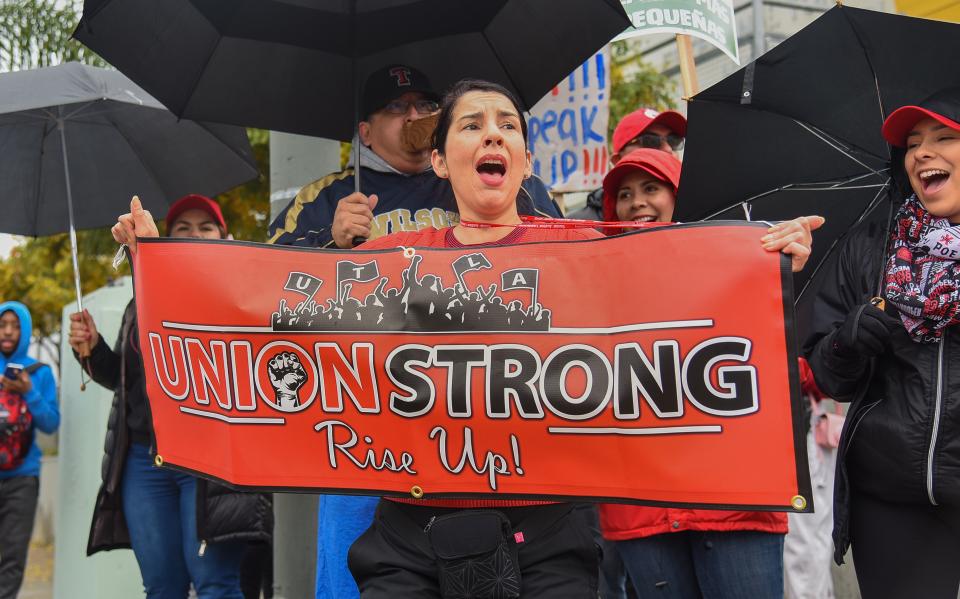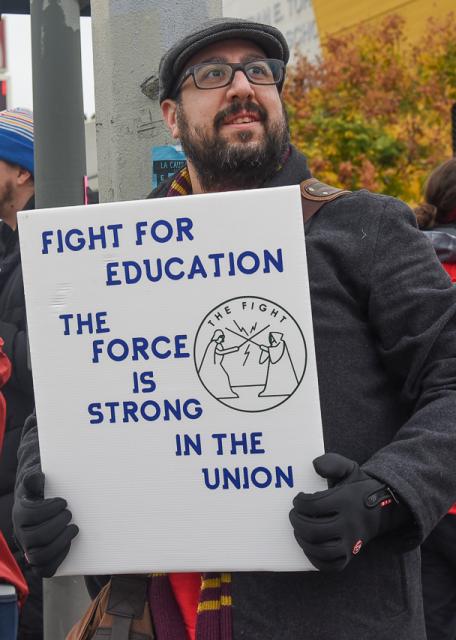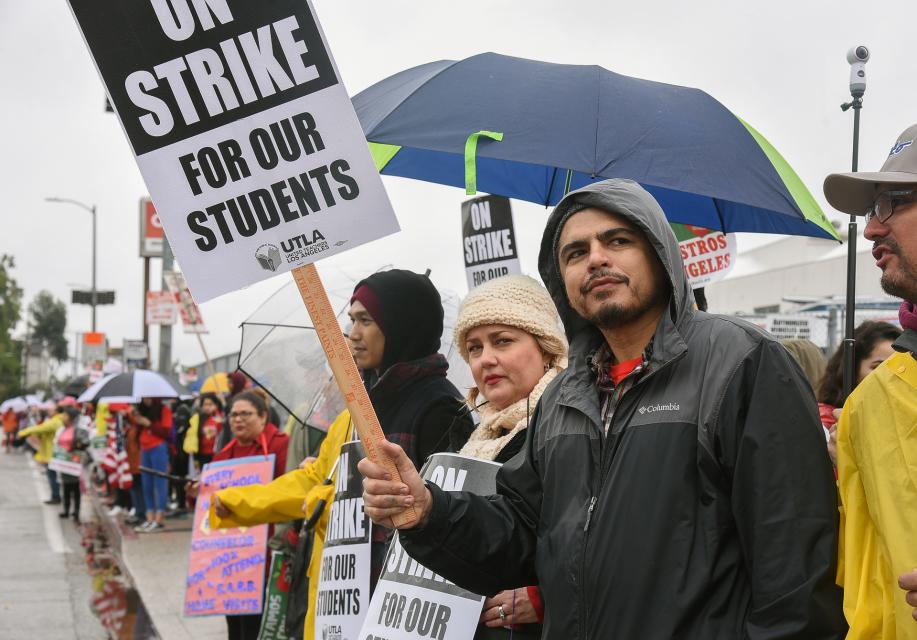UTLA’s fight to save public education resonated far and wide. Messages of solidarity and selfies of fist-pumping teachers poured in from Kentucky to Canada. Union locals across Los Angeles set up support networks for more than 200 LAUSD schools. For Writers Guild members, joining teachers on picket lines was an opportunity to pay back their mentors.
UTLA’s strike against the Los Angeles Unified School District drew broad support from parents and retirees, as well as a fired-up union movement itching to take the offensive against the Trump Administration and corporate privatizers.
Labor solidarity began with classified staff and other LAUSD employees, and rippled outward through a broad range of unions with deep roots in communities served by public education.
SEIU Local 99 represents about 30,000 LAUSD staff, including food services workers, special education assistants, custodians and bus drivers. Seventy percent of Local 99 members are graduates of district schools and nearly half are parents or guardians of school-aged children.
“As parents of LAUSD students and educators,” said Local 99 Executive Director Max Arias, “many of us also feel very strongly about the need for urgent change to improve our public schools.”
Local 99 members Frank Alas-Alegría and Yvette Monzón gathered pledges from 87 of the 91 classified staff at their school to strike in solidarity with UTLA. Monzón said Local 99 members remember when teachers stood with them last spring, when Superintendent Austin Beutner dug in his heels during their contract talks.
On day one of the UTLA strike, nearly 400 Local 99 members at 10 schools walked out with teachers. On day five, hundreds of additional staff struck at 10 more schools. Arias said the strike brought teachers and classified employees together like never before.
“The strike lifted up our voices as educators, as parents, as members of our communities who care deeply about the future of our children,” Arias said.
When we fight, we win!
Rusty Hicks is president of the Los Angeles County Federation of Labor AFL-CIO, known to unionists simply as “the Fed.” Hicks has taught in the L.A. Community College District, and is a member of the Los Angeles College Faculty Guild, AFT Local 1521. The native Texan is also an Afghan War veteran and officer in the Navy Reserve.
Hicks likes a good fight. He stayed close to UTLA during nearly two years of negotiations, and watched the earlier “Fund the Fight” campaign that kicked off the mobilization with great interest.
“A victorious strike doesn’t happen overnight,” he said. “For UTLA, it was years in the making.”
Hicks was already moving the Fed’s significant resources months before the strike. The executive board voted to recognize any action that UTLA believed necessary, and the website added a portal for 300 local union affiliates to “adopt” a school. During the walkout, support networks operated at 214 schools, and the United Way-affiliated Community Services Office aided hard-pressed families.
“A strong labor movement has strong community allies,” he said.
“A victorious strike doesn’t happen overnight. For UTLA, it was years in the making.”
The Fed turned toward activism during the 1990s under UFW-trained Miguel Contreras, followed by Maria Elena Durazo, head of the militant hotel workers local, widow of Contreras, and now a state senator.
Hicks and a new generation of Fed staff members have continued the trend. The new spirit among labor and community activists is, “When we fight, we win!”
“We owe our teachers a debt.”
Entertainment industry unions have been a major segment of the Los Angeles labor movement for 100 years and Hollywood talent on both sides of the cameras stepped up to support UTLA.
On day two, more than 50 members of the Screen Actors Guild and American Federation of Television and Radio Artists, picketed in the driving rain at the Hollywood and Highland Center. SAG-AFTRA Secretary-Treasurer Jane Austin said, “It’s all about showing solidarity and supporting better education for our children.”
Teamsters Local 399 – the “Hollywood” truck drivers – adopted Dixie Canyon Elementary in the San Fernando Valley for picketing. “Teamsters don’t cross picket lines!” the Local 399 website reminded drivers. “We urge members to stand in solidarity with educators by honoring their picket lines.”
The Writers Guild of America West adopted Hancock Park Elementary, located near the union’s Westside headquarters, to picket with striking teachers. WGAW president David A. Goodman said supporting UTLA goes beyond labor solidarity for his union’s members.
“Many writers, like myself, went to public school and got our start as writers under the tutelage of dedicated teachers like the members of UTLA,” Goodman said. “We owe our teachers a debt. Without them, we wouldn’t be here.”
Keep up the good work
Media coverage of the UTLA strike sowed solidarity across the globe. Nikolas Wagner, an American working in Austria as an assistant English teacher, wrote to thank UTLA for actions that inspired him and his coworkers. Wagner included photos of them holding handmade signs in German.
“Your fight is the fight of workers everywhere,” he wrote. “Despite working under different contracts and a different educational system, I could tell that the UTLA demands resonated with my colleagues. Keep up the good work.”
The work has kept up. A yearlong drumbeat of teacher strikes leading up to the UTLA walkout highlighted how underfunded public education is, and how underpaid educators are. Since L.A’s Martin Luther King Day settlement, emboldened teachers in Oakland and Denver have walked out in their own contract negotiations and West Virginia teachers walked out again in opposition to legislative threats to cut funding.
The UTLA strike generated a surge of support for investing in public education. Opinion polls that once showed a majority of voters against paying more for schools have changed direction, and LAUSD is counting on voters to approve a parcel tax on the June ballot.
Teachers, meanwhile, mounted an enthusiastic campaign for a pivotal March 4 school board election. At last count, UTLA-endorsed candidate Jackie Goldberg was shy of the 50 percent she needed to win the open board seat outright, and will face Heather Repenning in a May 14 runoff.
And in the end the love you take …
The UTLA strike of 2019 will not be remembered for increased wages or benefits, although progress was made in both areas and other traditional contract issues. (See below)
The agreement raised the bar for two issues beyond the purview of LAUSD or UTLA — charter schools and education funding. Beutner and UTLA agreed that the school board would call on Sacramento to cap charter schools and commission a study on how charters have affected public schools.
UTLA, LAUSD and L.A. Mayor Eric Garcetti agreed to jointly advocate for increased county and state funding. Garcetti also endorsed the Schools and Communities First ballot initiative on the 2020 ballot.
The strike should be remembered for body-blocking the privatization of the second largest school district in the country; mobilizing parents and communities by bringing broader social issues to the bargaining table; and convincing officials at every level to invest more in public education – now.
— By Steve Weingarten, CFT Reporter
CONTRACT WINS FOR LOS ANGELES TEACHERS
- Class size reduction: Secondary school math and English classes will be reduced from 46 to 39 students this academic year, along with an additional reduction of one student per grade level. Class size will be reduced again by one one student during the 2020-21 school year, and by two additional students in the 2021-22 year. Also, Section 1.5, a contract provision that allowed the district to unilaterally ignore all class size averages and caps, is eliminated.
- Increased salary: A 3 percent retro salary increase for the 2017-18 school year and a 3 percent salary increase retroactive to July 1, 2018.
- More nurses: The district will hire 150 full-time nurses this school year, and at least 150 additional full-time nurses during the 2020-21 school year, which will provide a full-time nurse at every school five days a week.
- More librarians: The district will hire 41 full-time teacher-librarians this school year, and at least 41 more full-time librarians during the 2020-21 school year, which will provide a full-time librarian at every secondary school five days a week.
- More counselors: The district will hire at least 17 additional full-time counselors by this October, allowing the district to maintain a counseling service ratio of 500-1 per secondary school.
- More community schools: The district will designate 20 community schools by June 30, and designate an additional 10 community schools by June 30, 2020. These schools will have additional funding and UTLA positions.
NON-TRADITIONAL BARGAINING ISSUES
- Co-location monitoring: The district will provide UTLA a list of all schools threatened by co-location by December 1 and February 1 every year. At each co-located school, an elected UTLA co-location coordinator will help develop the “shared use” agreement.
- Reduce testing: This school year, a new joint UTLA/LAUSD committee will begin to identify all district assessments and develop a plan to reduce that number by half.
- Fewer random searches: A pilot program that exempts schools from administering random searches will be extended for up to 28 schools. This will be phased in by the 2021-22 school year and city services will be provided for student safety during the pilot.
- More green space: LAUSD, UTLA and the city of Los Angeles will create a joint task force to plan how to increase green space on campuses by December 2019, from removing bungalows and asphalt to create greener play areas, water retention systems, and Community School Parks.
- Immigrant Defense Fund: The district will provide a dedicated hotline and attorney for immigrant families and collaborate with UTLA for further services.



